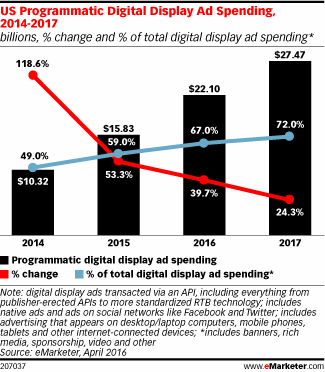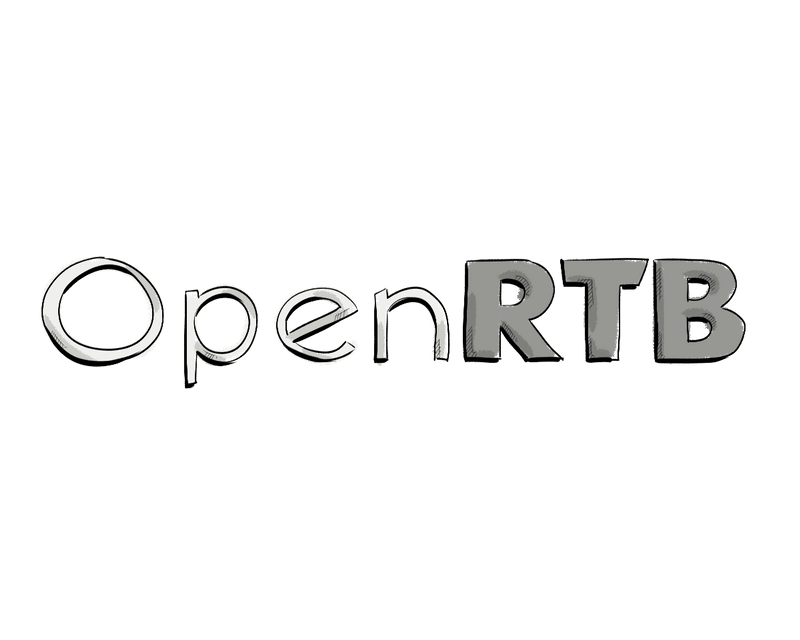Why should you care about OpenRTB – the open-source protocol developed in conjunction with a consortium of demand- and supply-side platforms and adopted by the IAB?
Consider one statistic…
According to eMarketer, programmatic ad spend is predicted to account for almost two-thirds of digital advertising in the US in 2017 – to the tune of over $27 billion.

And obviously these kinds of numbers just can’t be ignored.
Which will explain why almost all RTB-capable platforms have signed on to use the OpenRTB protocol.
Its efficiency, along with its advantages for both advertisers (quick access to competitively priced ad space) and publishers (greater yield on inventory combined with data monetization possibilities), have pushed RTB and programmatic to new heights.
It’s not hard to see where the popularity of the OpenRTB protocol has come from.
Who Benefits From OpenRTB?
The OpenRTB project was not formed by one single company, but rather as a consortium of supply- and demand-side companies interested in creating (in their words) “a lingua franca between buyers and sellers” to help them communicate and operate better.
In particular, that meant establishing object models and specifications for, among other things, the following:
- Bid requests and responses
- Ad formats
- Publisher and placement types
- Geolocation, device and other data definitions
The latest version, released for public comment in November 2016, also supports:
- Header bidding
- Billing and loss notification
- Outstream video
The result is a protocol that can truly benefit both sides of the equation.
Brands
A unified “language” to facilitate real-time bidding obviously makes life easier for advertisers. They can easily tap into any and all inventory sources that support RTB without worrying about being able to integrate their platform with their supply-side tools.
Thanks to OpenRTB, a brand’s DSP, for example, can support several different SSPs and add new ones if necessary. The end result is that they have way more opportunities to reach their target audience.
Agencies
The same can be said for ad agencies that want to offer their clients real-time bidding opportunities. In this instance, there is even more need for “universality” as agencies may be working with a wide range of brands that need access to worldwide inventory.
AdTech/MarTech Vendors
Finally, vendors of AdTech and MarTech solutions who want to incorporate RTB capabilities into their tools will find that adopting the standards of the OpenRTB project can make their offering much more attractive. Whether their clients already have an DSP or DMP in place or want to adopt one, they will want be sure that the tool they are spending money on isn’t going to be useless because it doesn’t work with other platforms.
Why Real-Time Bidding Capability Is Essential
Taking a step back, it is also important to not only to understand the numbers behind the growth of programmatic advertising and RTB, but why exactly it is so useful and why an initiative like OpenRTB is so essential.
Advertisers (and publishers too) have become attached to real-time bidding for media-buying and -selling for several reasons:
Data driven: Instead of hit-and-miss campaigns and rough insights into performance, RTB allows brands to continually optimize their campaigns based on all kinds of data, from ad placement, time of day, page content, visitor data, etc. Now that brands are getting used to having and using this data, they have come to expect it from their AdTech tools.
Scalability: One great advantage of real-time bidding is the ability to quickly and easily tap into global inventory – in real time. This means targeting wide swaths of a market across several countries or individual, high-value customers with ease – all without having to have a direct relationship with the media sellers and their platforms.
Personalization: One primary result of RTB’s scalability and data-driven operations is being able to personalize ads down to the most granular level. Now, when a visitor arrives on a site, he or she can be served distinctly personal ads that have a much greater appeal. Advertisers love this because of higher conversion rate potential and publishers love it because they can maximize the value of a single impression based on data and the ability to connect brands with the visitor in real time.
There are other advantages of RTB but these serve to highlight the main benefits advertisers and publishers derive from it. And as they become more and more used to them, they will not be able to do without RTB.
Benefits of Implementing the OpenRTB Protocol
Of course, advertising technology is a competitive industry. No one could expect that one single platform could take over and offer a fully integrated system in and of itself.
And yet with so many different tools available – from DSPs to DMPs to ad networks and ad servers – there needed to be a way to coordinate in such a fast-changing space.
This was the original impetus for the OpenRTB project in the first place – and it remains valid today.
With a common “language” of standardized communication, AdTech platforms can be more confident about scalability and their ability to integrate with a host of other players on the market.
More specifically, a universal protocol can help SSP & DSP platforms and ad exchanges by:
Saving maintenance costs: No need for SSPs and DSPs to support different integrations with multiple exchanges.
Reducing time to market: Ability to implement multiple integrations without added development costs for each additional integration. Some customization may be necessary but the core implementation will be the same thanks to a unified protocol.
Making it possible to switch platforms without substantial upfront integration costs: Flexibility when choosing a new partner/platform to work with.
And finally – since the OpenRTB standard has already been widely adopted with other tools, making it the basis of a new tool makes it infinitely more attractive (and useable) for potential customers.








